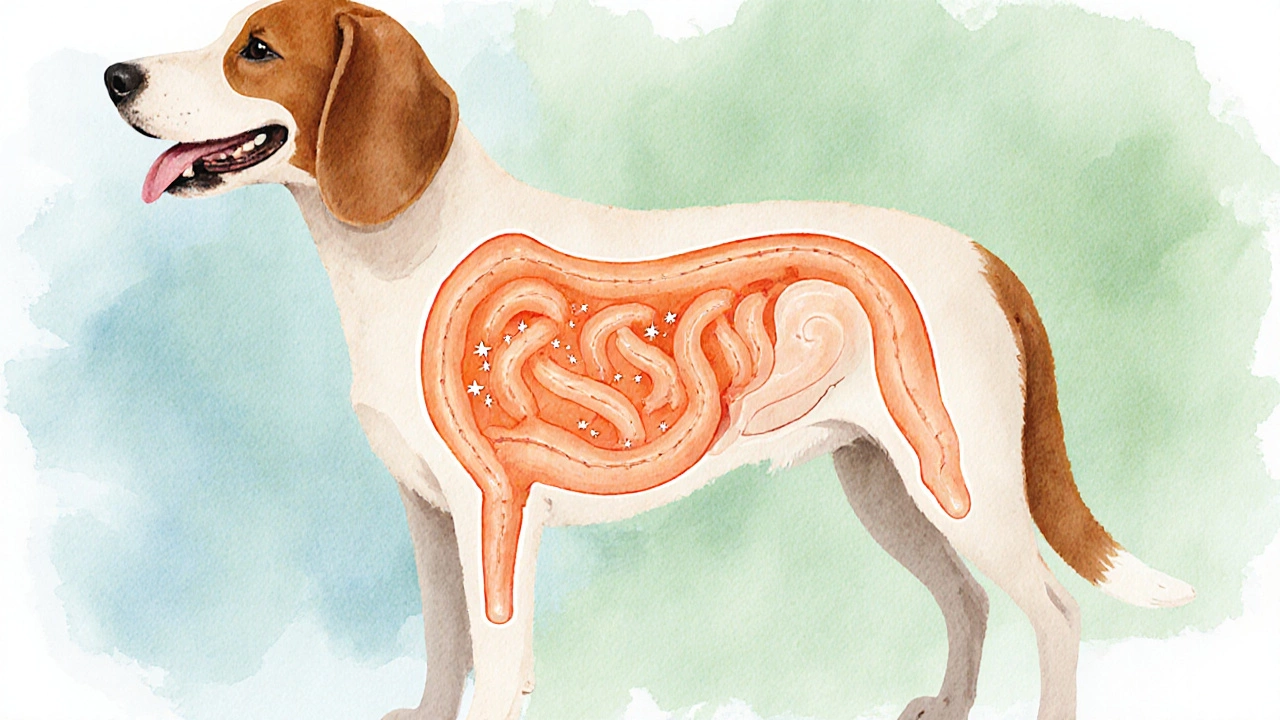Pumpkin Dosage Calculator for Dogs
Pumpkin Dosage Calculator
Calculate the appropriate daily pumpkin dosage for your dog based on weight and health needs. Always consult your veterinarian for specific recommendations.
Recommended Daily Dosage:
Mix with food twice daily for best results.
Important Safety Information:
This dosage is suitable for healthy dogs. Do not exceed 2 tablespoons daily for large dogs. Consult your vet if your dog has:
- Diabetes
- Pancreatitis
- Chronic digestive issues
When you spot a can of pumpkin sitting on the pantry shelf, you might wonder if it’s just a pie filler or a hidden health hack for your dog. The truth is, pumpkin for dogs does more than fill a bowl - it can smooth digestion, support weight control, and even brighten skin and coat. Below you’ll find a practical guide that walks you through the why, what, and how of adding pumpkin to your canine’s diet.
Quick Takeaways
- Pumpkin is rich in soluble fiber, which eases both constipation and diarrhea.
- Vitamin A and beta‑carotene promote healthy skin, vision, and immune function.
- Low‑calorie, high‑water content makes pumpkin a natural satiety aid for overweight dogs.
- Fresh, canned, or powdered pumpkin can be used safely when unsweetened and free of additives.
- Start with a tablespoon per 10 lb of body weight and watch for any signs of stomach upset.
What Is Pumpkin?
Pumpkin is a winter squash (Cucurbita pepo) that’s harvested when its flesh is firm and its skin turns deep orange. Historically it’s been a staple food for humans, but its nutritional profile also makes it a friendly supplement for dogs. The edible part is low in fat, high in water, and packed with fiber, vitamins, and antioxidants.
Key Nutrients That Matter for Dogs
Understanding the nutrient breakdown helps explain why pumpkin shows up in many canine health guides.
- Fiber - About 2 g per half‑cup; dissolves in water to form a gel that slows digestion.
- Vitamin A - Supports vision, skin, and immune response; roughly 3,500 IU per half‑cup.
- Beta‑carotene - An antioxidant that the body converts to vitamin A, helping combat oxidative stress.
- Potassium - Keeps muscle and nerve function in check.
- Vitamin C - Minor amounts, but still contributes to antioxidant defense.
Digestive Health: The Fiber Advantage
Canine gut issues are a top reason owners reach for pumpkin. Soluble fiber absorbs water, forming a mucous‑like coating that:
- Softens hard stool, easing constipation.
- Absorbs excess fluid in the intestines, firming up loose stool caused by diarrhea.
- Feeds beneficial gut bacteria, acting as a prebiotic.
Veterinarians often recommend a modest spoonful mixed into regular food for short‑term relief. For chronic conditions, a consistent daily dose can help maintain regularity.
Weight Management and Satiety
Obesity affects up to 60 % of the domestic dog population, leading to joint strain, diabetes, and reduced lifespan. Because pumpkin is low in calories (about 45 kcal per half‑cup) yet high in water and fiber, it adds bulk without a calorie surge.
Adding pumpkin to a meal can reduce overall food intake by up to 15 % in studies with medium‑size breeds. The gel‑like fiber slows gastric emptying, keeping dogs feeling full longer.

Skin & Coat: Vitamin A and Beta‑Carotene
Dry, flaky skin and a dull coat are common signs of nutritional deficiency. Vitamin A plays a direct role in skin cell turnover, while beta‑carotene offers antioxidant protection against UV‑induced damage.
Owners who incorporate a tablespoon of pumpkin into a weekly feeding schedule often notice a shinier coat within a month, especially in breeds prone to skin issues like Golden Retrievers and Boxers.
Blood Sugar Stability for Diabetic Dogs
Pumpkin’s low glycemic index (GI ≈ 75) means it raises blood glucose slowly. For dogs managing diabetes, a small amount of pumpkin can help smooth post‑meal spikes without adding significant carbs.
Always coordinate with your vet; the recommended dose for a 30‑lb diabetic dog is roughly 1 tsp per day, mixed into a protein‑rich meal.
Parasite & Gut Health Support
Recent research (2024 study by the University of Illinois College of Veterinary Medicine) showed that pumpkin fiber increased the population of Lactobacillus species in canine feces, which in turn reduced the load of common intestinal parasites like Giardia. The prebiotic effect creates an environment where harmful organisms struggle to thrive.
How to Serve Pumpkin Safely
Not all pumpkin products are created equal. Here’s a quick guide to picking the right form:
| Form | Processing | Typical Use | Pros | Cons |
|---|---|---|---|---|
| Fresh raw | Peel, seed, steam or bake | Homemade puree | No additives, maximum nutrients | Requires prep time |
| Canned puree | Cooked, packed in water, no added sugar or spice | Mix straight into kibble | Convenient, ready‑to‑use | Check label for sodium or additives |
| Pumpkin powder | Dehydrated and ground | Sprinkle over meals | Long shelf‑life, easy dosing | May contain fillers; verify purity |
| Commercial dog supplement | Blend of pumpkin extract with vitamins | Capsules or chewables | Targeted dosage, added nutrients | Higher cost |
When choosing canned puree, opt for brands that list “100 % pumpkin” as the sole ingredient. Avoid products with added sugars, spices, or pumpkin pie filling.

Dosage Guidelines
Start low and watch for reactions. A general rule of thumb:
- Small dogs (under 20 lb): ½ tsp per day.
- Medium dogs (20-50 lb): 1 tsp per day.
- Large dogs (over 50 lb): 1-2 tbsp per day.
Split the dose between two meals if you’re using pumpkin for digestive issues. Always provide fresh water alongside.
Potential Side Effects & Precautions
Pumpkin is safe for most dogs, but over‑feeding can cause:
- Loose stools (too much fiber).
- Caloric imbalance if used as a major meal component.
- Allergic reaction - rare, but look for itching or swelling.
If your dog has a history of pancreatitis, consult your vet before adding any new carbohydrate source, even low‑fat pumpkin.
Real‑World Success Stories
Case 1 - Bella, a 12‑year‑old Labrador, struggled with chronic constipation. After introducing 1 tbsp of canned pumpkin mixed with her dry kibble twice daily, her stool softened within three days and remained regular for months.
Case 2 - Max, a 30‑lb Border Collie with early‑stage diabetes, saw a 20 % reduction in post‑meal glucose spikes after his owner added 1 tsp of fresh pumpkin puree to his breakfast.
These anecdotes illustrate how a simple kitchen staple can become a versatile health tool.
Quick FAQ
Can I feed my dog pumpkin pie filling?
No. Pumpkin pie filling often contains sugars, spices, and artificial sweeteners that can upset a dog’s stomach or be toxic. Stick to plain pumpkin.
Is canned pumpkin the same as pumpkin puree?
Canned pumpkin is usually 100 % pumpkin packed in water, while pumpkin puree can be a mix of pumpkin and other vegetables. Always read the label - you want pure pumpkin without additives.
How often can I give my dog pumpkin?
A daily serving is fine for most healthy dogs, as long as you stay within the dosage guidelines based on weight. If you’re using it for a specific issue, follow your vet’s recommendation.
Can pumpkin help with my dog’s bad breath?
Indirectly, yes. By improving digestion and reducing intestinal waste, pumpkin can lessen the odor that travels up the esophagus. For breath issues, also consider dental hygiene.
What should I do if my dog has an allergic reaction?
Stop feeding pumpkin immediately and contact your veterinarian. Symptoms may include itching, swelling, or vomiting.
Putting It All Together
Pumpkin isn’t a miracle cure, but its fiber, vitamins, and antioxidants make it a low‑risk supplement that addresses several common canine health concerns. By choosing the right form, dosing appropriately, and monitoring your dog’s response, you can turn a seasonal vegetable into a year‑round wellness boost.
So the next time you open a can of pumpkin, consider offering a spoonful to your furry friend. It might just be the simple step that keeps tails wagging and tummies happy.





